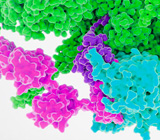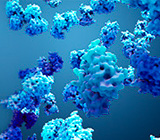-
REAGENT SERVICES
Hot!
-
Most Popular Services
-
Molecular Biology
-
Recombinant Antibody/Protein
-
Reagent Antibody
-
CRISPR Gene Editing
-
DNA Mutant Library
-
IVT RNA and LNP Formulations
-
Oligo Synthesis
-
Peptides
-
Cell Engineering
-
- CRISPR/Cas9 sgRNA
- CRISPR/Cas12a crRNA
- Prime Editing Guide RNA
- Base Editing Guide RNA
- HDR Templates
- gRNA + HDR Template Design Tools
- cGMP Guide RNA
- cGMP HDR Templates
- CRISPR/Cas Proteins
- CAR-T Knock-in Optimization Kit
- CRISPR Plasmids
- CRISPR gRNA Plasmid Libraries
- CRISPR Cell Lines
- Microbial Genome Editing
-
-
PRODUCTS
-
Most Popular Reagents
-
 Instruments
Instruments
-
Antibodies
-
ELISA Kits
-
Protein Electrophoresis and Blotting
-
Protein and Antibody Purification
-
Recombinant Proteins
-
Molecular Biology
-
Stable Cell Lines
-
Cell Isolation and Activation
-
 IVD Raw Materials
IVD Raw Materials
-
 Therapy Applications
Therapy Applications
-
Resources
-
- Pharmacokinetics and Immunogenecity ELISA Kits
- Viral Titration QC ELISA Kits
- -- Lentivirus Titer p24 ELISA KitHot!
- -- MuLV Titer p30 ELISA KitNew!
- -- AAV2 and AAVX Titer Capsid ELISA Kits
- Impurity Test ELISA Kits
- -- BSA ELISA Kit, 2G
- -- Cas9 ELISA KitNew!
- -- Protein A ELISA KitNew!
- -- His tagged protein detection & purification
- -- dsRNA ELISA Kit
- -- Endonuclease ELISA Kit
- COVID-19 Detection cPass™ Technology Kits
-
- Automated Maxi-Plasmid PurificationHot!
- Automated Mini-Plasmid PurificationNew!
- PCR Reagents
- S.marcescens Nuclease Benz-Neburase™
- DNA Assembly GenBuilder™
- Cas9 / Cas12a / Cas13a Nucleases
- Base and Prime Editing Nucleases
- GMP Cas9 Nucleases
- CRISPR sgRNA Synthesis
- HDR Knock-in Template
- CRISPR Gene Editing Kits and Antibodies
-
![AmMag™ Quatro Automated Plasmid Purification]() AmMag™ Quatro automated plasmid purification
AmMag™ Quatro automated plasmid purification
-
![Anti-Camelid VHH]() MonoRab™ Anti-VHH Antibodies
MonoRab™ Anti-VHH Antibodies
-
![ELISA Kits]() ELISA Kits
ELISA Kits
-
![Precast Gels]() SurePAGE™ Precast Gels
SurePAGE™ Precast Gels
-
![Quatro ProAb Automated Protein and Antibody Purification System]() AmMag™ Quatro ProAb Automated Protein and Antibody Purification System
AmMag™ Quatro ProAb Automated Protein and Antibody Purification System
-
![Target Proteins]() Target Proteins
Target Proteins
-
![AmMag™ Quatro Automated Plasmid Purification]() AmMag™ Quatro automated plasmid purification
AmMag™ Quatro automated plasmid purification
-
![Stable Cell Lines]() Stable Cell Lines
Stable Cell Lines
-
![Cell Isolation and Activation]() Cell Isolation and Activation
Cell Isolation and Activation
-
 IVD Raw Materials
IVD Raw Materials
-
![Quick
Order]() Quick Order
Quick Order
-
![Quick
Order]() Quick Order
Quick Order
- APPLICATIONS
- RESOURCES
- ABOUT US
- SIGN IN My Account SIGN OUT
- REGISTER

![Amino Acid Code Amino Acid Code]()
Biology Terms Dictionary
This Biology terms dictionary provides query services for biology and biochemistry terms. Please enter the biology or biochemistry terms you want to search.
List by Alphabet: A B C D E F G H I J K L M N O P Q R S T U V W X Y Z
CRISPR enzyme
Introduction
CRISPR enzymes are RNA-guided nucleases that have become indispensable tools in genome editing. Derived from bacterial immune systems, these enzymes—such as Cas9, Cas12, and Cas13—target specific nucleic acids based on sequence complementarity provided by guide RNA (gRNA). CRISPR enzymes enable precise DNA and RNA editing, revolutionizing genetic engineering in medicine, agriculture, and biotechnology.
Mechanisms of CRISPR Enzymes
- Acquisition of Foreign DNA: Bacteria integrate fragments of invading viral DNA into their CRISPR arrays, creating a record of previous infections.
- Expression of CRISPR Components: The CRISPR array is transcribed into pre-crRNA, which is processed into individual crRNAs. These crRNAs associate with tracrRNA to form a guide RNA, which then loads onto enzymes like Cas9 to facilitate targeting.
- Target Recognition and Binding: The enzyme identifies the correct genomic region by scanning for a PAM sequence, enabling precise binding of the gRNA to its complementary sequence:
- Cas9: Requires the NGG PAM sequence.
- Cas12: Uses more relaxed PAM constraints for expanded targeting capabilities.
- Nucleic Acid Cleavage: CRISPR enzymes induce specific types of cuts:
- Cas9: Generates blunt-end double-strand breaks (DSBs).
- Cas12: Produces staggered DNA cuts.
- Cas13: Targets RNA molecules for cleavage.
- Repair Mechanisms and Genetic Modifications: After cleavage, cellular DNA repair pathways are activated:
- NHEJ (Non-Homologous End Joining): A quick but error-prone repair process that often introduces indels.
- HDR (Homology-Directed Repair): A precise but less efficient pathway utilizing donor templates for specific edits.
Applications of CRISPR Enzymes
- Gene Therapy: CRISPR-Cas9 holds promise for correcting genetic disorders such as cystic fibrosis and Duchenne muscular dystrophy.
- Agriculture: CRISPR technology enables the development of crops with improved traits, including drought resistance and enhanced productivity.
- Epigenetic Regulation: Using dCas9 fused with transcription factors allows modulation of gene expression without altering DNA sequences.
- Diagnostics: Cas12 and Cas13 enzymes have been harnessed in platforms like SHERLOCK for rapid and sensitive detection of pathogens, including SARS-CoV-2.
- Drug Discovery: CRISPR-based genetic screens help identify disease-related genes and potential therapeutic targets.
GenScript Services and Products
- Custom Guide RNA (gRNA) Synthesis: High-quality gRNA tailored to specific target sequences, ensuring optimal editing efficiency.
- Cas9 Nuclease Catalog Products: Optimized for high CRISPR editing efficiency across various gene targets and cell types.
- Integrated CRISPR/Cas Protein Solution: Provides comprehensive solutions and services related to CRISPR/Cas gene editing technology.
Challenges and Limitations
CRISPR enzyme technology faces several challenges:
- Off-target Effects: Unintended cuts in the genome can result in undesirable mutations.
- Delivery Methods: Efficient delivery of CRISPR components into cells remains a technical challenge, with viral vectors and nanoparticles being commonly used carriers.
- Immune Responses: Human exposure to bacterial-derived CRISPR proteins may elicit immune reactions.
- Ethical Concerns: Issues surrounding germline editing necessitate careful regulatory oversight.
Conclusion
CRISPR enzymes, including Cas9, Cas12, and Cas13, have revolutionized genetic engineering by providing precise tools for DNA and RNA editing. Their wide-ranging applications in medicine, agriculture, and diagnostics continue to drive scientific innovation. However, challenges such as off-target effects and delivery limitations require further optimization. GenScript’s specialized CRISPR products and services play a critical role in advancing research by offering high-quality reagents and expert support, facilitating the seamless integration of CRISPR technology into diverse scientific endeavors.
- Tags:
- Protein
Related Biology Tools
-
GenSmart™ Codon Optimization
GenSmart Optimization is a free online tool for performing codon optimization to improve gene expression. GenScript's patented algorithms are integrated into the tool to optimize the computing capability of high-performance sequence generation.
-
DNA Construct Design Tool
GenSmart™ Design is a free online DNA construct design tool developed by GenScript. GenSmart™ Design has two design modules, the Create Construct module for individual plasmid design and the Create Library module for DNA library design.
-
Codon Frequency Tables
This online tool shows commonly used genetic codon frequency table in expression host organisms including Escherichia coli and other common host organisms.
Service and Products

Protein Expression
GenScript recombinant protein and rAb services provide high quality recombinant proteins and rAbs for a variety of downstream research applications.

Bacterial Expression
One-stop service from Sequence to Protein starting from $1600, 4 weeks.

Insect Expression
GenScript's BacuVance baculovirus expression system was developed by our in-house team of scientists for virus production and expression of recombinant proteins from baculovirus-infected insect cells.

Mammalian Transient Expression
Proprietary High Density (HD) expression system, enhance the protein yield up to 100 fold, achieve antibody titers up to 3 g/L.

Reagents for COVID-19 Research
Gram level, ready to ship RBD proteins, ACE2 assay cell lines and pseudovirus.
-
Top Search
-
Hot Glossary
-
Antibody
If you know of any terms that have been omitted from this glossary that you feel would be useful to include, please send detail to the Editorial Office at GenScript: website@genscript.com
If your term is adopted, we will send 1,000 EzCoupon points to your GenScript account.
-





































